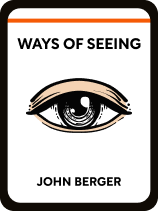

This article is an excerpt from the Shortform book guide to "Ways of Seeing" by John Berger. Shortform has the world's best summaries and analyses of books you should be reading.
Like this article? Sign up for a free trial here .
What is John Berger’s Ways of Seeing about? What is the key message to take away from the book?
In his book Ways of Seeing, John Berger argues that, throughout history, the way we see art has been manipulated by a privileged minority to preserve their social and economic dominance. Berger’s premise is that the dominant class has always used art and art criticism to “mystify” the working class.
Here’s a brief overview of Ways of Seeing by John Berger.
John Berger’s Ways of Seeing
John Berger’s Ways of Seeing challenges the idea that, to understand and appreciate works of art, we need experts to “translate” them for us. Rather, Berger urges us to pull back the curtain and look at the images before us with our own eyes. Using Marxist-feminist theory, Berger demonstrates how the elite mystifies art analysis and, by doing so, preserves the very capitalism that he’s criticizing.
The Book’s Author
John Berger (b. 1926, d. 2017) was a modern renaissance man: He was a painter, teacher, poet, Booker Prize winning novelist, essayist, screenwriter, playwright, journalist, and—most famously—art critic. He is best known for his BBC television series “Ways of Seeing” and its companion book: Ways of Seeing. Berger was born, raised, and educated in London, England, but spent the second half of his life in France, where he died at the age of 90.
Though never an official member of the Communist Party of Great Britain, Berger kept close ties with the association and was a leading figure in the British New Left—a political movement with strong ties to Marxist thought and which advocated for a range of progressive changes to society. Berger’s social and political views greatly influenced his work.
Publicly Available Works by John Berger:
- Read Ways of Seeing (1972)
- Watch “Ways of Seeing,” the original television series on BBC (1972).
The Book’s Publication and Context
Publisher: Penguin Books (1972)
Historical Context
“Ways of Seeing”—the BBC documentary series on which this book is based—was broadcast in January of 1972, and Ways of Seeing was published later that year. At this time in history, the Western world was in the throes of social, political, and cultural transformation. Beginning in the 1960s, enough time had passed following World War II that society shifted from an emphasis on rebuilding to a focus on social issues. Marginalized groups (particularly women and racial minorities) were fighting for equal rights, and hippie culture prioritized self-realization over materialism. Berger’s ideas were presented at a time when society was ready and willing to embrace a shift in perspective—especially to one that criticized the establishment.
Intellectual Context
“Ways of Seeing” has been heralded as a revolutionary response to Kenneth Clark’s 1969 BBC art program, “Civilisation,” which traces European art history from the Middle Ages to the early 20th century. In his program, Clark argues that art holds an inherent meaning that only an experienced art historian can uncover; in other words, there is a correct way to interpret art if you are educated and experienced enough.
Berger held a decidedly different perspective: that the meaning of art is relative to who views it, along with its place and time in history. Berger was also deeply concerned with class stratification and the contributions and circumstances of people traditionally left out of art history, whereas Clark (who hailed from a wealthy family) wasn’t.
While Clark set an example for a means of public conversation about art, Berger’s arguments have been more foundational to modern discourse. In 2018, the BBC series “Civilisations,” by Simon Schama, Mary Beard, and David Olusoga took up the project of updating and expanding the concept of “Civilisation” to cover world art history, not just European art history. Though it’s a direct line to Clark’s original, many commentators say the series owes a greater debt to John Berger and “Ways of Seeing” for its emphasis on individual and cultural relativity.
The Book’s Impact
Berger’s ideas in Ways of Seeing inspired fierce debate on both sides of the Atlantic and spurred what has been described as a revolution in the way we think about art and art history. Today, Ways of Seeing is a foundational text in many college art courses and has sold over a million copies.
The Book’s Critical Reception
Following Berger’s death in 2017, critics took a renewed interest in Ways of Seeing. Contemporary reviews of the 50+ year-old book are overwhelmingly positive, with many noting how relevant Berger’s views still are today—particularly regarding the exploitation and voyeurism of the female form.
Of the critiques of the series (and, therefore, the book), one pattern emerged: Critics take issue with the way Berger describes the European tradition of oil painting—most commonly, they disagree with his stance that the “masters” broke with conventional methods and, as a result, shouldn’t be used to analyze the time period’s painting traditions.
The Book’s Approach
Ways of Seeing is a collection of seven untitled essays, three of which are visual and contain no text. Berger informs the reader that these essays can be read in any order, and while each essay focuses on a different topic, there are connecting themes of perspective (“ways of seeing”), and mystification.
In the book’s introduction, Berger emphasizes that his text isn’t a prescription for one way to think about and interpret art; rather, it’s an invitation to think critically about the way art is presented to us and how we’re told to interpret it.

———End of Preview———
Like what you just read? Read the rest of the world's best book summary and analysis of John Berger's "Ways of Seeing" at Shortform .
Here's what you'll find in our full Ways of Seeing summary :
- Why we don't need experts to "translate" works of art for us
- How the dominant class uses art and art criticism to “mystify” the working class
- How our experiences and beliefs influence what we see






